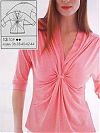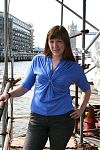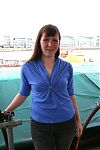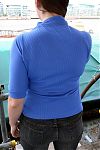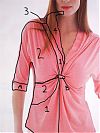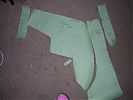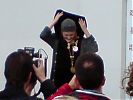I had a busy weekend of sewing, but it was mostly alterations and some beginning work on James’s linen shirt, and not terribly exciting. I’m finding recently that sewing is a useful bartering tool – in the span of two days last week I managed to trade some alteration work for several technical CAD drawings of our bedroom and lounge renovations, and also for the installation of new tongue & groove wall boards in our captain’s cabin bedroom! But amongst all the DIY work over the long, Bank Holiday weekend, I managed to sneak in a quick knit top I’ve been coveting from the April KnipMode magazine.
I had my eye on this ever since I saw it on the cover of the magazine, but I was recently asked questions about its construction over email, and thinking about it and dissecting the pieces got me REALLY excited to make it and I felt I needed a break (and a boost) from all the technical work on the linen shirt, so I just had to sew it up right away! So thank you, Linda, for inspiring me to make this even sooner!
This was a really quick top – it took less than two hours from start to finish, including cutting time, but it does take quite a lot of thought beforehand to understand exactly how this pieces together. It also doesn’t help that the technical drawing for this is absolutely awful and doesn’t show the correct seam lines or the shoulder gathers. I think the photos are more helpful here so I’ve drawn on the approximate seam lines overtop (pardon my wobbly lines – I was at home without my graphics tablet!):
The real twist in this pattern is how piece 2 curves back on itself and creates a tiny little hole for the central loop to go through. It makes sense when you’re sewing it, but on paper, the pattern pieces really look weird, but they do have a lot of symbols to match up to help out. I laid out how the front pieces fit together on the floor first to show approximately how the front of the shirt fits together (be aware that the pattern piece for the back, #3, is split and needs to be joined with the end of the sleeve before cutting your fabric. KnipMode and Patrones do this sometimes when the pattern pieces won’t fully fit on their sheets).
With all patterns in another language, however, you have to come up with your own order of construction if you don’t want to spend every other word on Google Translate. Some people might ask, well, how do you know which order to sew everything?
After sewing enough patterns, you tend to notice a rhythm to the order in which basic garment types are constructed: piece the front together, piece the back together, attach at the shoulders, finish the neckline, sew and attach the sleeves, sew the side seams, finish the sleeves and hem.
In case anyone else wants to take the plunge and make this top (which I heartily recommend!!), here’s my construction order, in more detail:
KnipMode April 2008 #13
- Join pieces 1 and 2 between the closed circle and the star
- Join piece 1 to the other piece 1 between the open circle and the hem at the centre front
- Gather (“rimple”) along the tops of pieces 1 and 2 between the filled square and the filled circle
- Join the fronts (1 and 2) to the back (piece 3) along the whole shoulder and upper arm seam, matching up those filled squares and circles
- Sew the centre back seam of the neckband, piece 4, and fold that lengthwise and attach it to the neckline of pieces 3 and 1, aligning the open squares to piece 1 and putting 4’s seam at the centre back of 3
- Then form the central gathering on the front of the top, which is mostly just folding piece 2 back onto itself so that the two filled triangle pieces match up, and sew piece 2 to itself between the filled triangle and the “opening” mark
- There are two pieces you have to measure out for yourself – A is the sleeve band that just attaches onto the end of the sleeve, and a tiny B piece which is the bit in the very centre of the top (this looks too small to have seam allowances included so I definitely think you have to add them onto these drawn pieces, too).
- Finish the edges of piece B (I just doubled it and made it a turned loop) and thread that through the openings on the two 2 pieces and fasten on the wrong side.
- Then finally sew the underam and side seams, attach the sleeve bands, and finish the hem.
The only change I made to this pattern was to shorten the sleeves by about two inches so that the band fell just above my elbow. I have a very well loved RTW blue knit top with sleeves this length that I was looking to pay tribute to. I find that elbow length sleeves stay put whereas 3/4 length sleeves tend to bunch up for me. The only other change I might make in the future is to take in the centre front seam a bit in the bottom, as I notice I get a little pouch of fabric there depending on how I’m standing, but that’s a very minor (and very easy to fix!) complaint. Though depending on your figure, a bit of extra room there may not be such a bad thing!
I’m really pleased I got to use this blue ribbed knit I bought in Dublin – it’s so soft and super stretchy and comfortable, and I think this pattern was the perfect match for it. With all the twists and turns, it’s really cool to see the obvious grain lines in the subtle stripes and appreciate how everything’s moving around. I’d love to see this in a stripey fabric, as you could really play up the stripes on the sleeve and neckband to a greater extent than I did here!
Oh, and last of all, I was walking home on Friday night when I noticed a huge throng of paparazzi photographers outside the Design Museum. And then a cloaked woman came out and revealed herself to be Dame Vivienne Westwood!!
She only stayed out for literally 20 seconds but it was enough to me to get this photo with my camerphone! It was very, very exciting to see such a design icon less than 100 metres from my home!

